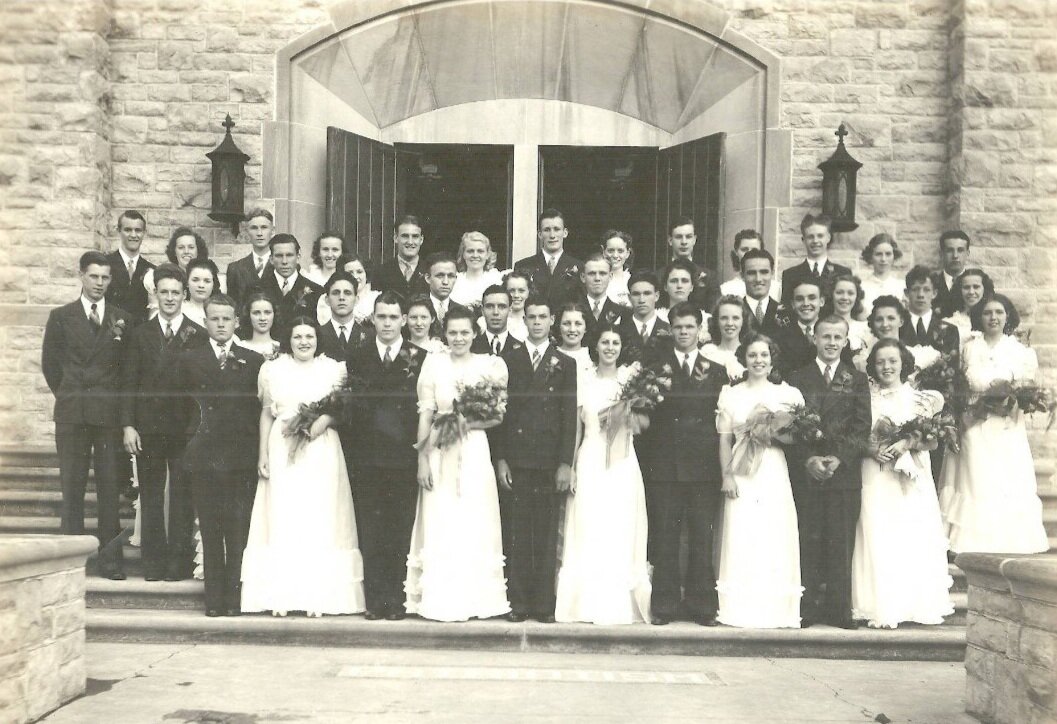By Emily Rinaman, Technical Services Librarian
You can’t watch a sporting event or weekday sitcom on television without inevitably seeing a commercial for one of the many vehicle options these days (that is, of course, unless you routinely DVR your favorite shows in order to fast-forward through the advertisements).
For the hard-working dad there are trucks “built to last” for all his tough jobs in the rugged wilderness. For the adventurous, there’s 4-wheel drives that promise to cruise right through the Utah salt flats or Great Bear Dunes of Michigan. And for the over-booked chauffeur—I mean, mom—there’s the luxurious van with built-in entertainment for the children so she can get some “me” time as she drives.
But 100 years ago, our grandparents, great-grandparents and even great-great grandparents didn’t have those options. They either walked, rode bikes or horses, or hopped on a streetcar.
Now, I don’t know about you, but when I hear the word “streetcar” my mind instantly paints an image of a Victorian woman in downtown San Francisco, her white puffy sleeves standing out against the backdrop of a red trolley going up a steep hill with the Pacific Ocean in the distance. But at one time, streetcars actually existed in many urban cities throughout the United States, and even smaller municipalities like Tiffin.
Preceding the electric streetcar was a horse-drawn streetcar. According to the book “Between the Eighties, Tiffin, Ohio, 1880-1980” by Myron Barnes, the first horse-drawn streetcar in Tiffin began on July 4, 1888. In the early 1830s, major cities like New York, for instance, began constructing streetcar systems. By the 1840s-1850s, they had become a main mode of transportation for thousands of urban dwellers.
Taken from the Tiffin-Seneca Sesquicentennial, 1817-1967.
Tiffin’s horse-drawn streetcars took its residents to parks on the outer edges of town for a day of relaxation and socializing. Concerts were held at one such park, Highland Park, a 15-acre area located in “Stoner Woods” on the corner of what is now Wall St. and Eighth Ave.
Eventually electric streetcars started replacing horse-drawn cars. They were seen as an improvement because they eliminated horse manure droppings and could operate for longer periods of time (a typical horse could pull a trolley for a maximum of five hours before it needed to rest). Horse-drawn and mule-drawn streetcars were pretty much gone by the 1920s in the U.S., but did last through the mid-1950s in parts of Mexico and Ireland.
It wasn’t until the 1890s that Tiffinites saw electric streetcars in their own town. The Tiffin, Fostoria and Eastern Electric Railway (formerly the Tiffin & Fostoria Electric Railway) operated lines from 1898 until it was sold to the Toledo, Fostoria & Findlay Railway in 1925 (which disbanded a mere five years later). At one point, there was close to six miles of streetcar tracks around Tiffin.
Riverview Park (not the same as the present Riverview Park) was another popular destination by way of streetcar for Tiffin residents. The Yellow Street Car Line (electric) took residents to the park for 5 cents a fare, which at one time had boating, tennis courts, and even a dance pavilion. During this same time period it was quite “fashionable” to take a streetcar out to Meadowbrook Park in Bascom in the summer.
The Tiffin-Fostoria-Eastern Line, taken from Tiffin Street Cars & Public Utilities.
By the late 1930s, most of these streetcar lines, including the ones in Ohio, had been abandoned as cars and buses become the transport of choice for the majority of the population. Locally, the Tiffin-Fremont-Fostoria Bus Lines carried passengers until 1953.
After the automobile was invented, many streetcar companies, which were privately owned, became bankrupt. Just like mergers in today’s business world, larger streetcar companies bought out smaller ones. Even automobile companies such as General Motors, Firestone Tire and Rubber Company and Standard Oil of California “bought interest in transit companies and encouraged the conversion from streetcar to bus,” stated the National Museum of American History.
There was also an issue of road space and upkeep. When cars took over, they really took over the streets—crowding the streetcar lines and forcing them to halt. A right-of-way rule had yet to be established, let alone traffic lights or stop signs. (And god forbid, turn signals!) So, people became impatient (even back then) to get wherever they were going.
Two Tiffin residents, Dr. Henry Wenner and Judge James Platt, were even killed when their car collided with a streetcar on their way to a Cleveland Indians game in 1933.
In the summertime we often grumble under our breath when we hit a corner and lo, and behold, road construction. Our tax dollars are being converted into fresh pavement to patch those pesky potholes. But even streetcar mongers had to worry about improvements—their fares to ride the streetcar could be compared to the tolls we pay on turnpikes.
So, unless you are one of the five percent of Americans who ride public transportation on a regular basis, don’t take the luxury of your modern vehicle for granted. With air conditioning, cup holders, customizable music and heated seats, automobiles have come a long way.
Works cited:
Barnes-Josiah Hedges and His Descendants, Myron Barnes. https://www.ohiomemory.org/digital/collection/p15005coll27/id/22645/rec/1
Between the Eighties, Tiffin, Ohio 1880-1980, Myron Barnes, 1982. https://www.ohiomemory.org/digital/collection/p15005coll27/id/552/rec/1
Historical Business Review Seneca County, 1891-1892. https://www.ohiomemory.org/digital/collection/p15005coll27/id/15499/rec/1
“Interurbans, Classic American Streetcars”, https://www.american-rails.com/interurbans.html#OH
Seneca County Ohio, History & Families, Seneca County Genealogical Society, 1998. https://www.ohiomemory.org/digital/collection/p15005coll27/id/28323/rec/20
“Streetcar,” Encyclopedia Britannica, https://www.britannica.com/technology/streetcar
Stromberg, Joseph. “The Real Story Behind the Demise of America’s Once-mighty Streetcars”. https://www.vox.com/2015/5/7/8562007/streetcar-history-demise 2015.
Tiffin Parks, Past to Present, League of Women Voters, https://www.ohiomemory.org/digital/collection/p15005coll27/id/34925/rec/6
Tiffin Street Cars and Public Utilities, 1965. https://www.ohiomemory.org/digital/collection/p15005coll27/id/22390/rec/1
“The Trolley and Daily Life”. Smithsonian, National Museum of American History. https://americanhistory.si.edu/america-on-the-move/streetcar-city
Wikipedia.com
Seneca County Digital Library, Ohio Memory Project, https://ohiomemory.org/digital/collection/p15005coll27









